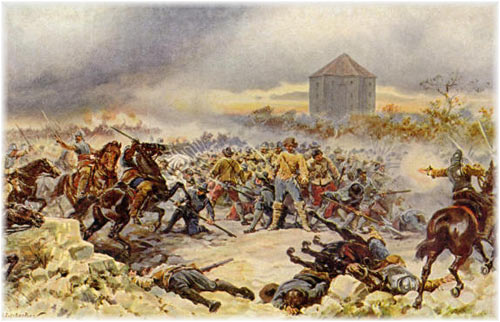The Thirty Years War raged across Europe in the 17th century with the Habsburg powers of Spain and the Holy Roman Empire clashing with Saxony, Sweden, France, and many others. While many place Albrecht von Wallenstein at the height of Habsburg strength, one commander of the Catholic League forces is overlooked- Johann Tserclaes, count von Tilly.

Tilly was born in the Spanish Netherlands in 1559 to Jesuits, the “warriors” of the Catholic Church. Tilly’s first combat experiences were in the 80 Years War against the Dutch with the Spanish. When Tilly was 35, he joined the Habsburg forces to fight the Turks in the Hungarian plains.
In 1609, Maximilian I of Bavaria created the Catholic League as opposition to the Protestant Union and Tilly was called upon to reform the Bavarian forces. The league would offer military support to any of its allies when provoked, and in 1618, the Holy Roman Empire called upon the League for aid. Ferdinand II claimed to own Bohemia & the Palatinate, ruled over by Frederick V, since his father had previously ruled the land. In an attempt to reclaim their lands, the Habsburg monarch turned to his Catholic allies to the west. Tilly’s forces combined in 1619 at Wurzburg, where the entire force numbered around 20,000. 7,000 of these men were Bavarian soldiers whom Tilly had previously commanded. The Bohemian revolt spread into Moravia, Styria, the Tyrol, and other parts of the Holy Roman Empire.
On November 8, 1620, Tilly’s Catholic forces clashed with the Czechs at the Battle of White Mountain. Outnumbering his opponent by almost 10,000 men, Tilly knew this battle would clear the way to Prague and it was imperative for him to win. The Czech forces of the Bohemian Estates (hereby known as the Estates) positioned themselves on high ground overlooking a valley. Artillery was places throughout the Estates’ lines while the middle was populated by Czechs and Austrian mercenaries. The Imperial forces under Count von Tilly were set in three lines with Cossacks from Poland and Spanish cavalry on the flanks. Imperial cavalry on the right wing charged the Estate positions to which their commander, Christian Anhalt, could not respond to. The left collapsed as the Estate infantry and cavalry routed. Anhalt commanded his middle to attack the Imperial forces but Tilly absorbed these assaults and managed to surround the Czech, who was captured. Irish Catholic Henry Fitzsimon led his troops to crush the rest of the Estate forces and Tilly achieved a stunning victory. Tilly continued past Prague and into Germany where he continued his string of impressive victories, much to the admiration of Ferdinand II.

By 1625, Christian IV of Denmark sought ambitions to the south in the ever expanding 30 Years War. Tilly and Albrecht von Wallenstein led their forces north in order to confront the Protestant forces and in 1626, Tilly confronted the enemy at the Battle of Lutter. Tilly’s artillery was used to a massive advantage and when they repulsed a Danish assault, a cavalry charge routed the reorganizing Danes from the battlefield. Lutter cost the Danes some 6,000 men out of their 20,000; Tilly lost 200 men. With the Imperials in Jutland, Christian IV was forced to sign the Treaty of Lubeck which made him abandon support to the German Protestants.
Tilly was appointed commander of the Imperial Army afterthe Wallenstein debacle. Wallenstein’s power hungry manner and ignorance toward the Emperor cost Wallenstein his life. With Count von Tilly in command, Ferdinand II ordered him to move against the Swedish forces of Gustavus Adolphus who had invaded Germany in 1630. The Swedes had adopted Maurician tactics of the 80 Years War and created arguably the best fighting force of the pike and shot era. Tilly’s siege of Magdeburg ended in a victory, but his invasion of Saxony cost him an important ally. At Breitenfeld in 1631, Gustavus Adolphus’ forces devastated Tilly as his flank attempt was refused and eventually slaughtered by the Swedish-Saxon force. Tilly was forced to retreat back to Bohemia after losing 27,000 soldiers. Tilly positioned his troops on the River Lech and Gustavus Adolphus attacked rapidly. Tilly was wounded and died two weeks later.
While not the most notable general of the 30 Years War, Johann von Tilly remains an intriguing man whom we do not explore often. From being a Flemish soldier in the armies of the Holy Roman Empire to fighting off Czechs in the Bohemian Estate Wars, Tilly proved to be a major player of early 17th century warfare. His quick and comitted decisions led to many victories, but also drastic defeat at Breitenfeld. His quick death in a minor engagement really puts a stamp on his life and makes one realise how quickly even a general can fall from grace.
